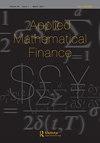风电期货定价的非高斯Ornstein-Uhlenbeck模型
Q3 Mathematics
引用次数: 34
摘要
最近引入的基于德国风电生产指数的风电期货在建模和定价方面带来了新的有趣挑战。该产品的一些特点是,标的价格具有很强的季节性成分,风指数受上方和下方的限制,而且期货是根据综合生成的现货指数结算的。在这里,我们考虑由Barndorff-Nielsen和Shephard在风力发电指数建模的背景下提出的非高斯Ornstein-Uhlenbeck型过程。讨论了模型的性质和模型参数的估计。此外,该模型还提供了风电期货定价的分析公式。我们提供了一项实证研究,其中模型被校准为37年的德国风力发电生产指数,该指数是在假设装机容量不变的情况下综合生成的。同时,基于1年风电期货不同交割期的观察价格,我们研究了风险的市场价格。一般来说,我们发现负风险溢价的大小随着交割期的增加而减小。为了进一步证明我们提出的模型的好处,我们解决了风电期货的欧洲期权定价问题,这可以通过傅里叶技术实现。本文章由计算机程序翻译,如有差异,请以英文原文为准。
A non-Gaussian Ornstein–Uhlenbeck model for pricing wind power futures
ABSTRACT The recent introduction of wind power futures written on the German wind power production index has brought with it new interesting challenges in terms of modelling and pricing. Some particularities of this product are the strong seasonal component embedded in the underlying, the fact that the wind index is bounded from both above and below and also that the futures are settled against a synthetically generated spot index. Here, we consider the non-Gaussian Ornstein–Uhlenbeck type processes proposed by Barndorff-Nielsen and Shephard in the context of modelling the wind power production index. We discuss the properties of the model and estimation of the model parameters. Further, the model allows for an analytical formula for pricing wind power futures. We provide an empirical study, where the model is calibrated to 37 years of German wind power production index that is synthetically generated assuming a constant level of installed capacity. Also, based on 1 year of observed prices for wind power futures with different delivery periods, we study the market price of risk. Generally, we find a negative risk premium whose magnitude decreases as the length of the delivery period increases. To further demonstrate the benefits of our proposed model, we address the pricing of European options written on wind power futures, which can be achieved through Fourier techniques.
求助全文
通过发布文献求助,成功后即可免费获取论文全文。
去求助
来源期刊

Applied Mathematical Finance
Economics, Econometrics and Finance-Finance
CiteScore
2.30
自引率
0.00%
发文量
6
期刊介绍:
The journal encourages the confident use of applied mathematics and mathematical modelling in finance. The journal publishes papers on the following: •modelling of financial and economic primitives (interest rates, asset prices etc); •modelling market behaviour; •modelling market imperfections; •pricing of financial derivative securities; •hedging strategies; •numerical methods; •financial engineering.
 求助内容:
求助内容: 应助结果提醒方式:
应助结果提醒方式:


